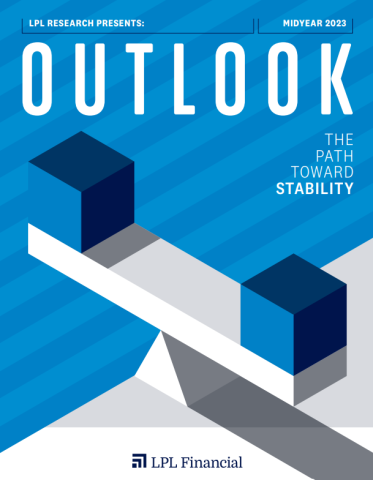
Midyear Outlook 2023: The Path Toward Stability
The economy and markets made progress toward regaining balance in the first half of 2023, but more work lies ahead. Reclaiming that state of balance helps us feel grounded, rooted in stability and the comfort of the familiar.
OVERVIEW
Our 2023 investing outlook started with a theme of returning to normalcy. Considering 2022’s market volatility and the aftereffects of the pandemic, the idea of finding balance was certainly a welcomed change. It’s a theme we could all embrace six months ago and what we will continue to rally around through year-end. That’s not to say that 2023 hasn’t come with its own set of challenges. We saw two regional banks fail in rapid-fire succession in March—and another closed its doors in May. Collectively representing over $530 billion in assets, the trio ranks as the second, third, and fourth largest bank failures to date. We also held our breath as a last minute deal to raise the debt limit came together as the clock ticked closer to default. Despite the market gyrations these events caused and a banking sector still on tenterhooks, the overall financial system seems stable. Counterbalancing the challenges, some bright spots include:
- Inflation is under 5% at home, significantly lower than its 8.3% level this time last year
- The fed funds rate has potentially reached its apex with the Federal Reserve’s (Fed) quarter percent rate increase in May
- Global inflation has ticked down from its 8.7% high in 2022, and is following a slow descent to a projected 6.5% for 2023
By and large, these are things we know, definitively or directionally, a guiding force that shapes our perspective on the next six months or so. Like anything, they come with some potential opportunities for investors—opportunities that may present themselves in international equities, core bonds (particularly if the Fed is indeed done raising rates), and industrials to name a few.
On the flip side, there are uncertainties out there. Recession is probably the biggest unknown, with some of the biggest questions around when it might hit, how long it might last, and how significant it could it be. That said, any recession that occurs would appear to be more in the mild range at this point. Perhaps recession is the largest unknown, but we should also factor in the possibility for interest-rate volatility. For example, rates could move higher if inflation remains stubbornly high. Or, they could see a fairly sizable move lower in the event of recession.
Ultimately, how rate volatility resolves itself will be a big driver for markets. Clearly the LPL Research team doesn’t have a crystal ball. But there are two things we know. The insights in this report will help position investors, along with guidance from their financial professional, to achieve their goals. Second, our seasoned team of experts will be by your side, providing guidance and actionable insights as the second half unfolds.
ECONOMY
The baseline forecast is the domestic economy slides into recession in the late half of 2023 as consumer demand cools, especially for services. If job growth cools and the unemployment rate rises, consumers will likely experience declining disposable income, which could be the impetus for a recession as consumers pull back on spending. But in the near term, consumers are still unleashing pent-up demand for services. We expect the Fed to end its rate hiking campaign in the latter half of this year and introduce the possibility of a cut in rates as economic conditions weaken. But as inflation convincingly cools, markets will likely respond favorably to the slight pivot in Fed policy. So far, an improving Chinese economy has not had a material impact on global inflation.
STOCKS
In the first half of 2023, progress was made toward better balance as inflation fell and interest rates stabilized. However, macroeconomic risks remain top of mind as a potential recession looms. Earnings are likely to decline this year, but solid revenue growth and stable profit margins may help limit the magnitude of any decline. An improved inflation outlook by year-end may enable market participants to see through the economic malaise and toward recovery in 2024. Against this backdrop, LPL Research sees modest second-half gains for stocks, though with the potential for elevated volatility, until investors get more clarity on the likely depth and duration of a potential recession.
BONDS
After the most aggressive rate-hiking campaign in decades from the Fed, short-term interest rates are at levels last seen in the early 2000s. At the currently elevated levels, the risk is that these rates won’t last, and upon maturity, investors will have to reinvest proceeds at lower rates. So, unless investors have short-term income needs, they may be better served by reducing some of their excess cash holdings and extending the maturity profile of their fixed income portfolio to lock in these higher yields for longer. If the Fed is finished raising interest rates, we could start to see lower yields on intermediate-term securities before the Fed actually cuts rates. Historically, core bonds, as proxied by the Bloomberg Aggregate Bond Index, have performed well during Fed rate hike pauses.
GEOPOLITICS
The global dynamic has shifted as 2023 has progressed. An attempt to forge a negotiated settlement to end the Russia-Ukraine conflict was thwarted by an unflinching determination by both sides to win at all costs. Chinese President Xi Jinping is the latest world leader to offer a framework for ending the fighting. This framework also helps underpin China’s unrelenting determination to establish a global leadership position, as it seeks to broaden its trade and political relationships and undermine the economic power that the U.S. commands. Regarding U.S. and China bilateral relations, the backdrop has become increasingly fraught with concerns that China has intensified its efforts to secure technology that enhances its military buildup.
COMMODITIES
As prospects for the reopening of China finally became a reality, analysts cautioned that demand for industrial metals from the world’s second largest economy would help ignite a bout of inflation. Concerns that the global economy was nearing the cusp of a downturn placed significant pressure on oil prices, though China’s economic activity was initially delayed due to an escalation in COVID-19 cases. Still, the pace of economic growth in China is projected to gain momentum in the second half of 2023, potentially improving demand for a broad swath of commodities. Precious metals, however, have seen robust interest and higher prices as global central banks have been major buyers.
CURRENCIES
The U.S. dollar, as measured against a basket of developed market currencies, has been trending steadily lower since reaching 20-year highs late last September, as the key factors that were so supportive of the strengthening dollar for much of the last two years have dissipated. With markets pricing in easing from the Fed beginning early next year, the dollar’s large interest-rate advantage has eroded, making the dollar a relatively less attractive destination for global capital. Global usage of the dollar is more than stable. Nearly 90% of global foreign currency transactions involve the dollar, which suggests reports of the dollar’s imminent structural demise are greatly exaggerated.
ALTERNATIVE INVESTMENTS
Given the economic backdrop of the last six months, globally and at home, we’re constructive on alternative investments, which can offer portfolio diversification and performance that exceeds traditional benchmarks. It’s important to note that against our economic backdrop, we may see a wider range of performance among fund managers—depending on things like their trading style or geographic focus. This means that it will be more important than ever to understand the opportunities, risks, and overall strategy of any given alternative investment.
Click Here to Read the Full Midyear Outlook 2023: The Path Toward Stability
GENERAL DISCLOSURES
The opinions, statements and forecasts presented herein are general information only and are not intended to provide specific investment advice or recommendations for any individual. It does not take into account the specific investment objectives, tax and financial condition, or particular needs of any specific person. There is no assurance that the strategies or techniques discussed are suitable for all investors or will be successful. To determine which investment(s) may be appropriate for you, please consult your financial professional prior to investing.
Any forward-looking statements including the economic forecasts herein may not develop as predicted and are subject to change based on future market and other conditions. All performance referenced is historical and is no guarantee of future results.
References to markets, asset classes, and sectors are generally regarding the corresponding market index. Indexes are unmanaged statistical composites and cannot be invested into directly. Index performance is not indicative of the performance of any investment and does not reflect fees, expenses, or sales charges. All performance referenced is historical and is no guarantee of future results.
General Risk Disclosures
Alternative investments may not be suitable for all investors and should be considered as an investment for the risk capital portion of the investor’s portfolio. The strategies employed in the management of alternative investments may accelerate the velocity of potential losses.
Investing in stock includes numerous specific risks including the fluctuation of dividend, loss of principal and potential illiquidity of the investment in a falling market. Because of their narrow focus, sector investing will be subject to greater volatility than investing more broadly across many sectors and companies. Value investments can perform differently from the market as a whole. They can remain undervalued by the market for long periods of time. The prices of small and mid-cap stocks are generally more volatile than large cap stocks.
Bonds are subject to market and interest rate risk if sold prior to maturity. Bond values will decline as interest rates rise and bonds are subject to availability and change in price. Bond yields are subject to change. Certain call or special redemption features may exist which could impact yield. Government bonds and Treasury bills are guaranteed by the U.S. government as to the timely payment of principal and interest and, if held to maturity, offer a fixed rate of return and fixed principal value. Corporate bonds are considered higher risk than government bonds but normally offer a higher yield and are subject to market, interest rate, and credit risk, as well as additional risks based on the quality of issuer coupon rate, price, yield, maturity, and redemption features. Mortgage-backed securities are subject to credit, default, prepayment, extension, market and interest rate risk. Floating rate bank loans are loans issues by below investment grade companies for short term funding purposes with higher yield than short term debt and involve risk. Preferred stock dividends are paid at the discretion of the issuing company. Preferred stocks are subject to interest rate and credit risk. As interest rates rise, the price of the preferred falls (and vice versa). They may be subject to a call feature with changing interest rates or credit ratings. The majority of preferred stocks outstanding are concentrated in the financial sector.
International debt securities involve special additional risks. These risks include, but are not limited to, currency risk, geopolitical and regulatory risk, and risk associated with varying settlement standards. These risks are often heightened for investments in emerging markets.
High yield/junk bonds (grade BB or below) are not investment grade securities, and are subject to higher interest rate, credit, and liquidity risks than those graded BBB and above. They generally should be part of a diversified portfolio for sophisticated investors. Municipal bonds are subject to availability and change in price. They are subject to market and interest rate risk if sold prior to maturity. Bond values will decline as interest rates rise. Interest income may be subject to the alternative minimum tax.
Municipal bonds are federally tax-free but other state and local taxes may apply. If sold prior to maturity, capital gains tax could apply.
The fast price swings of commodities will result in significant volatility in an investor’s holdings. Commodities include increased risks, such as political, economic, and currency instability, and may not be suitable for all investors. Precious metal investing is subject to substantial fluctuation and potential for loss.
Any company names noted herein are for educational purposes only and not an indication of trading intent or a solicitation of their products or services. LPL Financial doesn’t provide research on individual equities.
All index data from FactSet. International investing involves special risks such as currency fluctuation and political instability and may not be suitable for all investors. These risks are often heightened for investments in emerging markets.
All information is believed to be from reliable sources; however, LPL Financial makes no representation as to its completeness or accuracy. Investing involves risks including possible loss of principal. No investment strategy or risk management technique can guarantee return or eliminate risk in all market environments. There is no guarantee that a diversified portfolio will enhance overall returns or outperform a non-diversified portfolio. Diversification does not protect against market risk.
The Bloomberg U.S. Aggregate Bond Index is an index of the U.S. investment-grade fixed-rate bond market, including both government and corporate bonds.
A company’s market capitalization is the market value of its outstanding shares. Market capitalization is calculated by multiplying the number of a company’s shares outstanding by its stock price per share. Classifications such as large-cap, mid-cap and small-cap are only approximations and may change over time.
Equity Definitions
Cyclical stocks typically relate to equity securities of companies whose price is affected by ups and downs in the overall economy and that sell discretionary items that consumers may buy more of during an economic expansion but cut back on during a recession. Counter-cyclical stocks tend to move in the opposite direction from the overall economy and with consumer staples which people continue to demand even during a downturn.
A Growth stock is a share in a company that is anticipated to grow at a rate significantly above the average for the market due to capital appreciation.
A Value stock is anticipated to grow above the average for the market due to trading at a lower price relative to its fundamentals, such as dividends, earnings, or sales.
Large cap stocks are issued by corporations with a market capitalization of $10 billion or more, and small cap stocks are issued by corporations with a market capitalization between $250 million and $2 billion.
Fixed Income definitions
Credit Quality is one of the principal criteria for judging the investment quality of a bond or bond mutual fund. As the term implies, credit quality informs investors of a bond or bond portfolio’s credit worthiness, or risk of default. Credit ratings are published rankings based on detailed financial analyses by a credit bureau specifically as it relates to the bond issue’s ability to meet debt obligations. The highest rating is AAA, and the lowest is D. Securities with credit ratings of BBB and above are considered investment grade. The credit spread is the yield the corporate bonds less the yield on comparable maturity Treasury debt. This is a market-based estimate of the amount of fear in the bond market. Base-rated bonds are the lowest quality bonds that are considered investment-grade, rather than high-yield. They best reflect the stresses across the quality spectrum.
The Bloomberg Aggregate U.S. Bond Index represents securities that are SEC-registered, taxable, and dollar denominated. The index covers the U.S. investment-grade fixed rate bond market, with index components for government and corporate securities, mortgage pass-through securities, and asset-backed securities
Investing in foreign and emerging markets debt or securities involves special additional risks. These risks include, but are not limited to, currency risk, geopolitical risk, and risk associated with varying accounting standards. Investing in emerging markets may accentuate these risks.
General Definitions
Gross Domestic Product (GDP) is the monetary value of all the finished goods and services produced within a country’s borders in a specific time period, though GDP is usually calculated on an annual basis. It includes all of private and public consumption, government outlays, investments and exports less imports that occur within a defined territory.
The PE ratio (price-to-earnings ratio) is a measure of the price paid for a share relative to the annual net income or profit earned by the firm per share. It is a financial ratio used for valuation: a higher PE ratio means that investors are paying more for each unit of net income, so the stock is more expensive compared to one with lower PE ratio.
Earnings per share (EPS) is the portion of a company’s profit allocated to each outstanding share of common stock. EPS serves as an indicator of a company’s profitability. Earnings per share is generally considered to be the single most important variable in determining a share’s price. It is also a major component used to calculate the price-to earnings valuation ratio.
The Standard & Poor’s 500 Index is a capitalization-weighted index of 500 stocks designed to measure performance of the broad domestic economy through changes in the aggregate market value of 500 stocks representing all major industries.
This material was prepared by LPL Financial, LLC.
Securities and advisory services offered through LPL Financial (LPL), a registered investment advisor and broker-dealer (member FINRA/SIPC).
Insurance products are offered through LPL or its licensed affiliates.
To the extent you are receiving investment advice from a separately registered independent investment advisor that is not an LPL affiliate, please note LPL makes no representation with respect to such entity.
Not Insured by FDIC/NCUA or Any Other Government Agency.
Not Bank/Credit Union Guaranteed Not Bank/Credit Union Deposits or Obligations May Lose Value.
For a list of descriptions of the indexes referenced in this publication, please visit our website at lplresearch.com/definition.
Tracking #1-05374553


